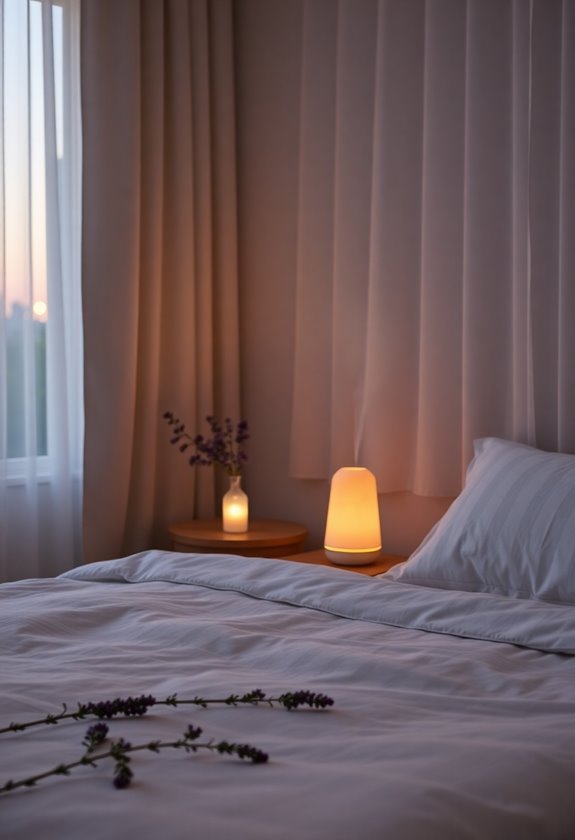You'll master anxiety-reducing sleep meditation through seven essential steps that combine breathing techniques and mindful relaxation. Start by creating a calm environment with dim lights and minimal distractions, then practice the 4-7-8 breathing method to activate your body's natural relaxation response. Progress through systematic body scanning from toes to head, acknowledging and releasing tension in each area. Focus on letting go of anxious thoughts while maintaining steady breath awareness, and establish a consistent nightly routine
Highlights
- Create a distraction-free environment with dim lights, comfortable bedding, and minimal noise to prepare for meditation practice.
- Begin with the 4-7-8 breathing technique to activate the body's natural relaxation response and slow heart rate.
- Practice body scanning from toes to head, releasing tension in each area while maintaining steady, mindful breathing.
- Establish a consistent nightly meditation routine at the same time to train your body and mind for relaxation.
- Use guided imagery or calming soundscapes while implementing progressive muscle relaxation techniques for deeper anxiety relief.
Understanding Sleep Meditation Benefits

Through guided sleep meditation, you can experience powerful relief from anxiety while improving your sleep quality. When you practice meditation regularly, you're activating your body's natural relaxation response, which helps counter the effects of daily stress and anxiety that often disrupt sleep.
Studies show that consistent daily practice helps establish an effective meditation routine.
- You'll notice your heart rate and breathing slow down naturally, making it easier to drift off to sleep
- Your body's parasympathetic nervous system becomes more active, promoting deep relaxation
- You'll experience fewer racing thoughts and decreased emotional reactivity at bedtime
The benefits you'll gain are comparable to those from medication or cognitive behavioral therapy, but without side effects. What's more, you're developing a valuable skill that creates a natural reflex for relaxation, making it progressively easier to fall asleep as you continue your practice. Many people find that combining meditation with natural sleep supplements can enhance their relaxation routine even further.
Setting Your Meditation Space

Now that you understand the powerful benefits of sleep meditation, let's focus on creating your ideal meditation space. You'll want to choose a quiet location where you can close the door and maintain solitude, ensuring it's free from clutter and distracting items. Research shows that regular practice sessions in a dedicated space can significantly improve your meditation consistency and results.
Start by setting up comfortable seating with proper back support, whether that's meditation cushions or a supportive chair. Add calming elements like soft lighting from lamps or candles, and consider incorporating natural elements such as plants or essential oils for a serene atmosphere. Using an essential oil diffuser can help distribute calming aromas throughout your meditation space. You'll benefit from creating a focal point for your practice, which could be a small object or peaceful image that helps maintain concentration. If external noise is an issue, try using soundscapes or implementing soundproofing solutions like rugs to create a more peaceful environment.
Mastering Deep Breathing Techniques

Deep breathing serves as the cornerstone of effective sleep meditation, calming both mind and body. You'll want to begin by finding your natural breathing rhythm, allowing each breath to flow without forcing or controlling it. As you settle in, focus your complete attention on the sensations of breathing, noticing how the air moves through your nostrils and fills your lungs. Positive self-talk during breathing exercises strengthens your sense of calm and relaxation.
- Practice the 4-7-8 method: inhale for 4 seconds, hold for 7, then exhale for 8
- Place your hands on your chest to feel the rise and fall of each breath
- Let your exhales become naturally longer than your inhales
- When thoughts arise, acknowledge them and return to your breath
- Notice the subtle differences between each breath without trying to change them
Body Scanning for Mental Peace

Building upon your mastery of breath awareness, body scanning offers a powerful technique to deepen your relaxation and prepare for restful sleep. This systematic practice helps you shift attention from racing thoughts to physical sensations, creating a natural pathway to mental peace.
To begin, lie comfortably in bed and direct your focus to different parts of your body, starting from your toes and moving upward. As you scan each area, you'll notice sensations without judgment while visualizing your breath reaching and releasing tension from these spots. Pain management benefits can be achieved through this mindful observation of bodily sensations. Similar to how massage therapy tools help release muscle tension, this practice activates your body's relaxation response, reducing fight-or-flight reactions and promoting parasympathetic activity that's essential for quality sleep.
Research shows that regular body scanning can greatly decrease anxiety, improve sleep quality, and help you maintain a more balanced emotional state throughout your day.
Releasing Anxious Thoughts

Racing thoughts and worry can create a barrier between you and peaceful sleep. Through mindful detachment and focused breathing, you'll learn to observe your anxious thoughts without getting caught up in them. When you combine deep breathing with visualization techniques, you're creating a powerful tool for releasing mental tension and promoting relaxation. Just as thoughts flow like water in a forest stream, let your worries drift away without resistance.
- Observe your thoughts as passing clouds, acknowledging them without attachment
- Focus on lengthening your exhales while visualizing tension leaving your body
- Use gentle self-affirmations to remind yourself that you're safe and supported
- Practice mindful awareness of the present moment, rather than future worries
- Allow your breathing patterns to guide you into a state of mental
Building Your Nightly Routine

A consistent nightly routine forms the foundation of restful sleep and reduced anxiety. You’ll want to establish specific actions that signal to your body it’s time to wind down, incorporating both meditation and relaxation techniques that work best for you.
Start by dimming the lights about an hour before bedtime and create a sleep-conducive environment that's cool, quiet, and dark. You'll need to minimize screen exposure, which can disrupt your natural melatonin production, and instead focus on calming activities like:
- Taking a warm bath
- Practicing short meditation sessions
- Using aromatherapy with calming scents
- Doing light stretches
- Reading a book under soft lighting
Consider using silk pillowcases to help maintain optimal sleep temperature and reduce friction against your skin while you rest.
Remember to
Maintaining Long-Term Success

Successful long-term meditation practice depends on your commitment to consistency and will. You'll find that maintaining your practice becomes easier when you establish a regular schedule and gradually increase your meditation duration from just a few minutes to longer sessions. By incorporating different techniques and staying adaptable, you'll create a sustainable practice that grows with your needs. Consider supplementing your meditation routine with natural anxiety relief products to enhance your relaxation practice.
- Set specific times for your nightly meditation to build a consistent routine
- Track your progress through regular self-reflection and feedback mechanisms
- Join meditation communities or groups for ongoing support and motivation
- Integrate complementary practices like yoga or breathing exercises
- Be willing to adjust your techniques when needed while maintaining core practices
Frequently Asked Questions
Can Guided Sleep Meditation Help With Chronic Pain Conditions?
Yes, guided sleep meditation can effectively help manage chronic pain conditions through multiple mechanisms. You'll benefit from breath regulation techniques that calm your nervous system and reduce pain perception, while body scanning helps release physical tension. When you practice visualization and positive affirmations during meditation, you're creating new neural pathways that can decrease pain sensitivity and improve your sleep quality.
How Do I Handle Interruptions During Guided Sleep Meditation Sessions?
"A journey of a thousand miles begins with a single breath" – especially when handling meditation interruptions. You'll want to:
- Prepare your environment by turning off notifications and closing doors
- Use downloaded guided meditations to avoid ad disruptions
- Practice the "note and return" technique – acknowledge interruptions without judgment, then gently redirect your focus to your breath
- Communicate your meditation schedule with household members to minimize disturbances
When interruptions occur, don't fight them – simply return to your practice with patience.
Should I Meditate in Bed or in a Different Room?
If your primary goal is falling asleep, you'll likely benefit from meditating in bed since it creates a seamless shift to sleep. However, if you're focusing on developing meditation skills or mindfulness practice, choose a separate room to maintain clear boundaries between meditation and sleep. You can also start in a different room for your main practice and end with a shorter bedtime meditation to combine both approaches.
What if I Fall Asleep During the Meditation Before It Ends?
While some worry about falling asleep during meditation, it's actually perfectly fine and can be beneficial. You're still absorbing the meditation's benefits through your subconscious mind, even while sleeping. Your brain continues processing the guided instructions, and the primary goal of relaxation is being achieved. If you consistently fall asleep before completion, you can try meditating earlier in the day when you're more alert.
Can Guided Sleep Meditation Be Combined With Sleep Medication?
Yes, you can safely combine guided sleep meditation with sleep medication, but it's crucial to discuss this approach with your healthcare provider first. Research shows that combining meditation techniques with prescribed sleep medications can actually enhance your overall sleep quality and potentially help reduce your long-term medication needs. When you're starting this combination, you'll want to maintain consistent bedtime routines and follow your doctor's specific dosing instructions carefully.




